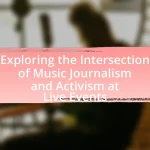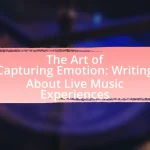Indie music festivals serve as vital platforms for emerging artists, offering opportunities for exposure, networking, and professional development. These events, such as SXSW and Coachella, showcase independent musicians, allowing them to perform in front of diverse audiences and industry professionals, which can lead to increased visibility and career advancement. The article explores how these festivals support new talent, the challenges artists face, and strategies for maximizing exposure, including effective performance tips and post-festival follow-up practices. Additionally, it highlights the importance of audience engagement and the resources available to help artists navigate the competitive music landscape.
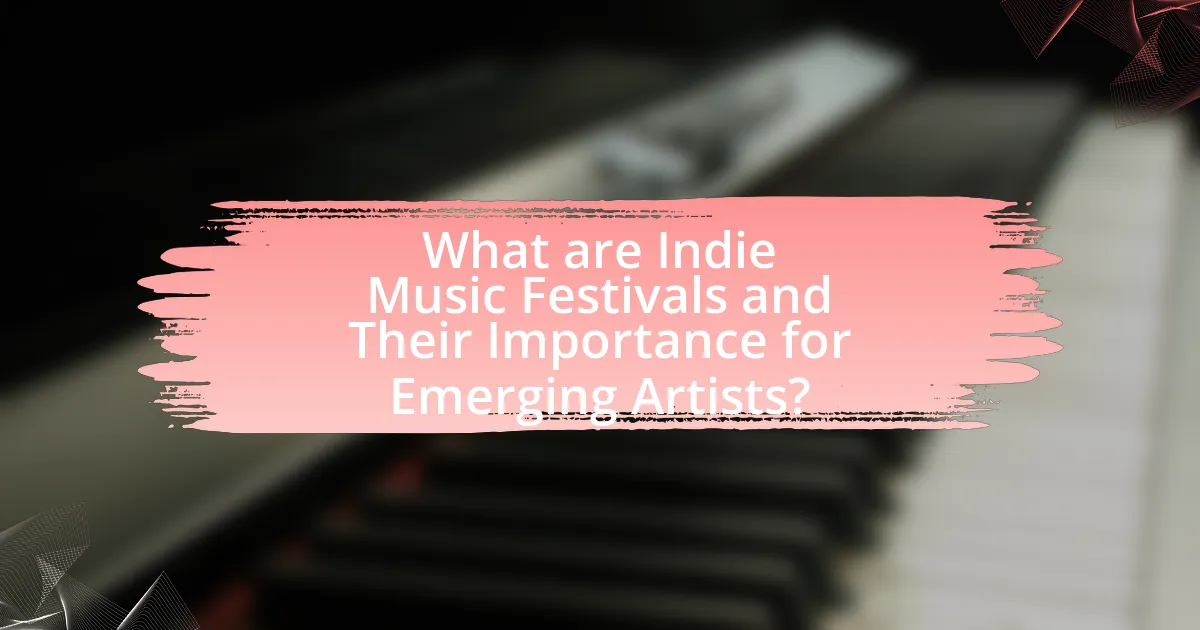
What are Indie Music Festivals and Their Importance for Emerging Artists?
Indie music festivals are events that showcase independent artists and bands, providing them a platform to perform and connect with audiences. These festivals are crucial for emerging artists as they offer exposure, networking opportunities, and the chance to gain a following in a competitive music industry. For instance, festivals like SXSW and Coachella have historically launched the careers of numerous artists by allowing them to perform in front of industry professionals and music enthusiasts. Additionally, indie music festivals often emphasize diversity and innovation, which aligns with the artistic vision of many emerging musicians, further enhancing their significance in the music landscape.
How do Indie Music Festivals support new talent?
Indie music festivals support new talent by providing a platform for emerging artists to perform in front of live audiences and industry professionals. These festivals often feature a diverse lineup that prioritizes independent musicians, allowing them to gain exposure and connect with fans. For instance, events like South by Southwest (SXSW) and Coachella have dedicated stages for up-and-coming acts, which can lead to increased visibility and opportunities for bookings. Additionally, many festivals offer networking events, workshops, and mentorship programs that facilitate connections between new artists and established industry figures, further enhancing their chances of success in the competitive music landscape.
What opportunities do these festivals provide for emerging artists?
Indie music festivals provide emerging artists with vital opportunities for exposure, networking, and professional development. These festivals often feature performance slots that allow new musicians to showcase their talent to diverse audiences, which can lead to increased visibility and potential fan engagement. Additionally, festivals typically attract industry professionals, including talent scouts and record label representatives, facilitating connections that can result in future collaborations or contracts. According to a report by the Music Industry Research Association, 70% of artists who perform at festivals report increased opportunities for bookings and collaborations post-event, underscoring the significant impact these festivals have on the careers of emerging artists.
How do festivals contribute to the growth of the indie music scene?
Festivals significantly contribute to the growth of the indie music scene by providing a platform for emerging artists to showcase their talent to larger audiences. These events often feature a diverse lineup of indie musicians, which helps to increase visibility and attract new fans. For instance, festivals like SXSW and Coachella have historically launched the careers of numerous indie artists, leading to increased streaming numbers and record sales post-event. Additionally, festivals foster networking opportunities among artists, industry professionals, and fans, which can lead to collaborations and further promotional opportunities. This ecosystem of exposure and connection is crucial for the sustainability and expansion of the indie music genre.
Why are Indie Music Festivals a platform for discovery?
Indie music festivals serve as a platform for discovery because they showcase a diverse range of emerging artists in an intimate setting. These festivals often prioritize independent musicians who may not have mainstream exposure, allowing attendees to experience new sounds and styles firsthand. For instance, events like SXSW and Coachella have historically featured breakthrough acts that later achieved significant commercial success, such as Billie Eilish and Hozier. This environment fosters a unique opportunity for artists to connect directly with audiences, facilitating organic growth and fan engagement.
What role do festival lineups play in showcasing emerging artists?
Festival lineups play a crucial role in showcasing emerging artists by providing them a platform to reach wider audiences and gain industry exposure. These lineups often feature a mix of established and up-and-coming talent, allowing new artists to perform alongside more recognized acts, which can significantly enhance their visibility. For instance, festivals like Coachella and SXSW have historically launched the careers of numerous artists, with data showing that over 60% of attendees discover new music at these events. This exposure can lead to increased streaming numbers, social media following, and opportunities for future performances, validating the importance of festival lineups in the music industry.
How do audience interactions at festivals impact artist visibility?
Audience interactions at festivals significantly enhance artist visibility by creating memorable experiences that engage attendees. When audiences actively participate, such as through cheering, dancing, or sharing content on social media, they amplify the artist’s reach beyond the festival grounds. For instance, a study by the University of Southern California found that social media posts featuring live performances can increase an artist’s online following by up to 30% within days of the event. This interaction not only boosts immediate visibility but also fosters a sense of community and loyalty among fans, leading to sustained interest in the artist’s work.
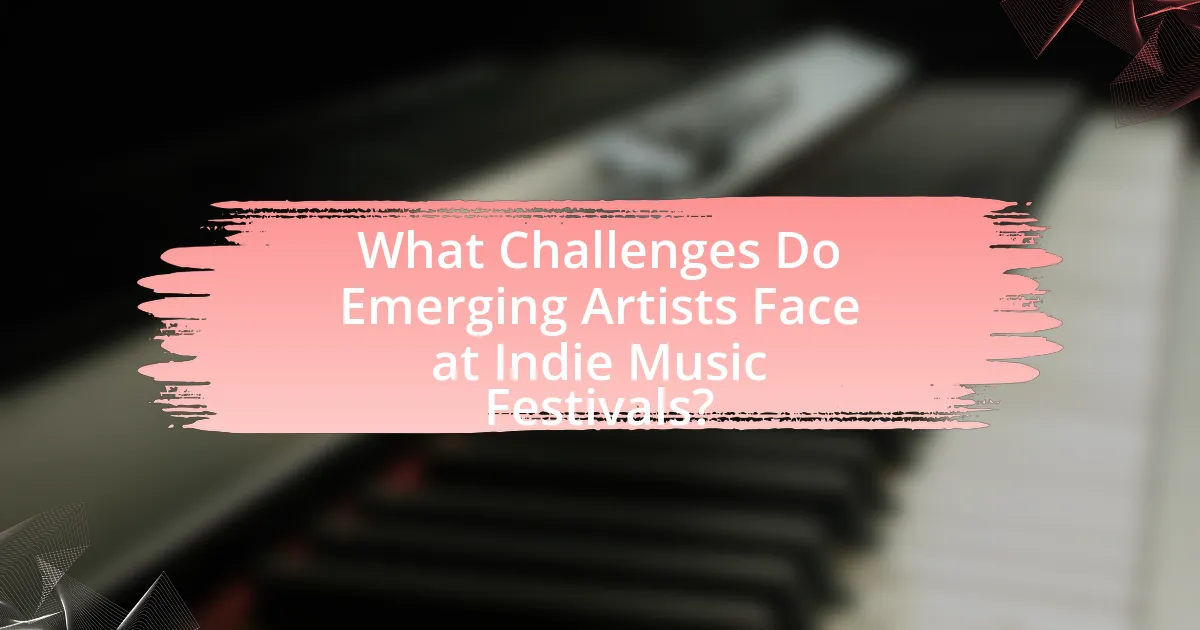
What Challenges Do Emerging Artists Face at Indie Music Festivals?
Emerging artists face significant challenges at indie music festivals, primarily including limited exposure, financial constraints, and competition. Limited exposure occurs because many festival-goers prioritize established acts, making it difficult for new artists to attract attention. Financial constraints arise from the costs associated with travel, accommodation, and promotional materials, which can be prohibitive for artists without substantial backing. Additionally, competition is fierce, as numerous emerging artists vie for the same audience and performance slots, often leading to a struggle for visibility and recognition. These challenges are supported by industry reports indicating that emerging artists often receive less than 10% of festival performance slots, highlighting the difficulty in gaining opportunities in such environments.
How do financial constraints affect participation in festivals?
Financial constraints significantly limit participation in festivals by restricting individuals’ ability to afford tickets, travel, and accommodation. Research indicates that high ticket prices and associated costs can deter potential attendees, particularly among lower-income demographics. For instance, a study by the National Endowment for the Arts found that 45% of individuals cited cost as a barrier to attending cultural events, including music festivals. This financial limitation not only affects audience turnout but also impacts the diversity of artists and performers, as emerging artists often rely on festival exposure for career advancement but may lack the funds to participate.
What funding options are available for emerging artists?
Emerging artists have several funding options available to support their creative endeavors. These options include grants from arts organizations, crowdfunding platforms, sponsorships from businesses, and music competitions that offer cash prizes. For instance, organizations like the National Endowment for the Arts provide grants specifically aimed at supporting new artists, while platforms like Kickstarter and Indiegogo allow artists to raise funds directly from their audience. Additionally, local businesses often sponsor events or artists in exchange for promotional opportunities, and competitions such as the International Songwriting Competition offer monetary rewards and exposure to winners. These funding avenues are crucial for emerging artists to develop their careers and gain visibility in the competitive music industry.
How can artists manage costs while maximizing exposure?
Artists can manage costs while maximizing exposure by leveraging social media platforms and collaborating with other artists. Utilizing social media allows artists to reach a wider audience without significant financial investment, as platforms like Instagram and TikTok have proven effective for music promotion. For instance, a study by the University of Southern California found that artists who actively engage on social media can increase their fan base by up to 30%. Collaborating with other artists can also reduce costs, as shared resources for marketing and performance can lead to greater visibility and lower individual expenses. This strategy not only enhances exposure but also fosters community within the indie music scene, which is crucial for emerging artists.
What logistical challenges do artists encounter at festivals?
Artists encounter several logistical challenges at festivals, including scheduling conflicts, transportation issues, and inadequate technical support. Scheduling conflicts arise when multiple acts are booked for overlapping time slots, complicating performance logistics. Transportation issues often involve delays or difficulties in moving equipment and personnel to and from the festival site, which can hinder timely setup and sound checks. Additionally, inadequate technical support, such as insufficient sound or lighting equipment, can impact the quality of the performance and the overall experience for both artists and audiences. These challenges are common in the festival environment, where coordination among various stakeholders is crucial for success.
How can artists prepare for performance logistics?
Artists can prepare for performance logistics by creating a detailed plan that includes venue specifications, equipment needs, and travel arrangements. This preparation involves researching the venue layout, understanding the technical requirements for sound and lighting, and coordinating with local teams for setup and breakdown. Additionally, artists should establish a timeline for rehearsals and sound checks to ensure everything runs smoothly on the day of the performance. According to a study by the National Endowment for the Arts, effective logistical planning significantly enhances performance quality and audience engagement, demonstrating the importance of thorough preparation in the success of live events.
What strategies can artists use to navigate festival environments?
Artists can navigate festival environments effectively by employing strategies such as networking, planning their schedules, and utilizing social media for promotion. Networking allows artists to build relationships with other musicians, industry professionals, and fans, which can lead to future opportunities. Planning their schedules helps artists maximize performance times and attend key events or workshops that enhance their visibility. Utilizing social media platforms enables artists to engage with their audience, share live updates, and promote their performances, which is crucial in a crowded festival setting. These strategies are supported by the fact that successful artists often attribute their growth to strong connections and effective self-promotion within festival contexts.
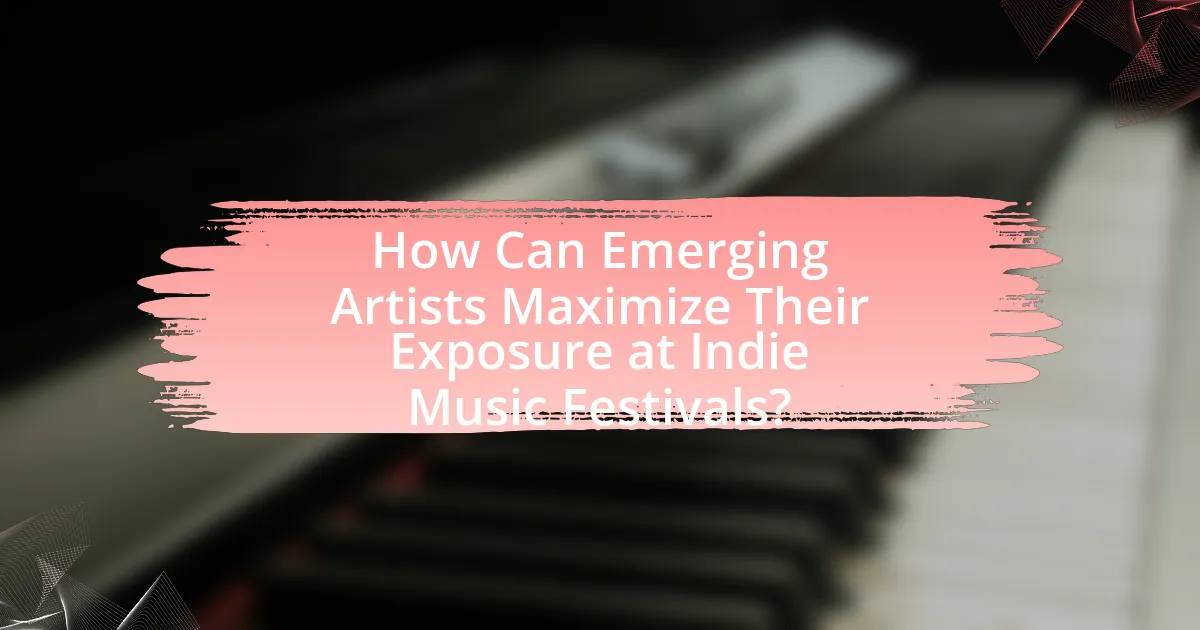
How Can Emerging Artists Maximize Their Exposure at Indie Music Festivals?
Emerging artists can maximize their exposure at indie music festivals by actively engaging with the audience and leveraging social media platforms. By performing high-energy sets and connecting with festival-goers, artists create memorable experiences that encourage word-of-mouth promotion. Additionally, utilizing social media before, during, and after the festival allows artists to share their performances, interact with fans, and reach a broader audience. Research indicates that artists who engage with their audience on platforms like Instagram and Twitter see a significant increase in follower counts and engagement rates, which can lead to more opportunities in the future.
What marketing strategies should artists employ before the festival?
Artists should employ social media marketing, email campaigns, and collaborations with influencers before the festival. Social media platforms like Instagram and TikTok allow artists to engage with their audience, share behind-the-scenes content, and promote their performances, which can increase visibility and anticipation. Email campaigns can be used to inform fans about festival details, ticket sales, and exclusive content, fostering a direct connection with the audience. Collaborating with influencers can amplify reach, as influencers can introduce the artist to their followers, creating a broader audience base. According to a study by HubSpot, 70% of marketers see increased engagement through social media, highlighting its effectiveness as a marketing strategy.
How can social media be leveraged for festival promotion?
Social media can be leveraged for festival promotion by creating targeted campaigns that engage audiences and build excitement. Platforms like Instagram and Facebook allow festival organizers to share visually appealing content, such as artist lineups, behind-the-scenes footage, and user-generated content, which can increase visibility and attract attendees. According to a study by Eventbrite, 95% of festival-goers use social media to discover events, highlighting its effectiveness in reaching potential audiences. Additionally, utilizing hashtags and collaborations with influencers can amplify reach and foster community engagement, driving ticket sales and enhancing the overall festival experience.
What role does networking play in maximizing exposure?
Networking plays a crucial role in maximizing exposure for emerging artists at indie music festivals. By establishing connections with industry professionals, artists can gain access to opportunities such as collaborations, performances, and media coverage. For instance, a study by the National Endowment for the Arts found that artists who actively networked reported a 30% increase in performance opportunities compared to those who did not. This demonstrates that effective networking not only enhances visibility but also facilitates career advancement in the competitive landscape of the music industry.
What are effective performance tips for emerging artists at festivals?
Effective performance tips for emerging artists at festivals include engaging the audience, optimizing stage presence, and preparing thoroughly. Engaging the audience can be achieved by making eye contact, encouraging sing-alongs, and interacting with fans, which fosters a connection and enhances the overall experience. Optimizing stage presence involves using the stage effectively, moving around, and showcasing energy, which can captivate the audience’s attention. Thorough preparation includes rehearsing setlists, sound checks, and understanding the festival’s layout, ensuring that artists are ready for any situation. These strategies are supported by the fact that audience engagement significantly increases performance ratings, as noted in studies on live music experiences.
How can artists engage the audience during their performance?
Artists can engage the audience during their performance by incorporating interactive elements such as call-and-response, audience participation, and storytelling. These techniques create a connection between the performer and the audience, enhancing the overall experience. For instance, studies show that performances that include audience interaction can increase emotional engagement and satisfaction, leading to a more memorable event. Additionally, artists who share personal stories or insights related to their music foster a deeper connection, making the audience feel more involved and invested in the performance.
What should artists consider when planning their setlist?
Artists should consider audience engagement, song flow, and venue dynamics when planning their setlist. Audience engagement is crucial as it helps maintain energy and connection throughout the performance; for instance, including popular tracks or fan favorites can enhance this interaction. Song flow involves arranging songs in a way that creates a cohesive experience, often alternating between high-energy and slower tracks to manage the audience’s emotional journey. Venue dynamics, such as the size and acoustics of the space, also play a significant role; artists may choose to adapt their setlist to suit the environment, ensuring that the performance resonates well with the audience. These considerations are supported by studies indicating that well-structured setlists can significantly impact audience satisfaction and overall performance success.
What are the best practices for post-festival follow-up?
The best practices for post-festival follow-up include sending thank-you emails to attendees, artists, and sponsors, collecting feedback through surveys, and sharing highlights on social media. Thank-you emails foster goodwill and encourage future participation, while surveys provide valuable insights into attendee experiences, helping to improve future events. Sharing highlights on social media keeps the festival’s momentum alive and engages the community, which is crucial for indie music festivals that rely on grassroots support. According to a study by Eventbrite, 78% of attendees appreciate follow-up communication, indicating its importance in maintaining relationships and enhancing future attendance.
How can artists maintain connections made during the festival?
Artists can maintain connections made during the festival by actively engaging with their contacts through social media, email follow-ups, and collaborative projects. Engaging on social media platforms allows artists to share updates and interact with fellow artists and fans, fostering ongoing relationships. Sending personalized emails to new contacts can reinforce connections and open doors for future collaborations. Additionally, participating in joint projects or performances with other artists can solidify these relationships and create a network of support. These methods are effective as they leverage existing platforms and communication channels that are widely used in the music industry, ensuring that connections remain active and beneficial.
What steps should artists take to evaluate their festival experience?
Artists should take the following steps to evaluate their festival experience: first, they should gather feedback from audience members and fellow performers to assess their performance impact. This can include collecting comments through surveys or informal conversations. Second, artists should analyze their own performance metrics, such as audience engagement and merchandise sales, to quantify their success. Third, they should review logistical aspects, including stage setup, sound quality, and scheduling, to identify areas for improvement. Finally, artists should reflect on their personal experiences and emotional responses during the festival to gauge overall satisfaction and growth. These steps provide a comprehensive framework for artists to critically assess their festival participation and enhance future performances.
What resources are available for emerging artists participating in festivals?
Emerging artists participating in festivals have access to various resources, including grants, mentorship programs, promotional platforms, and networking opportunities. Grants such as the National Endowment for the Arts provide financial support specifically for artists, while mentorship programs like those offered by organizations such as Artist Trust connect emerging artists with experienced professionals in the industry. Additionally, festivals often provide promotional platforms through social media and press coverage, enhancing visibility. Networking opportunities at these events allow artists to connect with industry professionals, which can lead to future collaborations and career advancements. These resources collectively support the growth and development of emerging artists in the competitive festival landscape.
How can artists access industry contacts and mentorship opportunities?
Artists can access industry contacts and mentorship opportunities by actively participating in indie music festivals, networking events, and workshops. These platforms often provide direct interaction with industry professionals, including producers, agents, and established artists who can offer guidance and connections. For instance, events like South by Southwest (SXSW) and Coachella feature panels and networking sessions specifically designed for emerging artists to meet influential figures in the music industry. Additionally, joining organizations such as the American Society of Composers, Authors, and Publishers (ASCAP) can facilitate access to mentorship programs and industry contacts through their extensive networks.
What tools can help artists track their progress and growth after festivals?
Artists can utilize various tools to track their progress and growth after festivals, including analytics platforms, social media insights, and project management software. Analytics platforms like Spotify for Artists and Apple Music for Artists provide detailed metrics on streams, listener demographics, and engagement, allowing artists to assess their reach and popularity post-festival. Social media insights from platforms such as Instagram and Facebook offer data on follower growth, engagement rates, and audience interactions, which are crucial for understanding fan response and building a community. Additionally, project management software like Trello or Asana can help artists set goals, track milestones, and organize feedback from festival performances, enabling them to plan future projects effectively. These tools collectively empower artists to make informed decisions based on concrete data, facilitating their growth in the competitive music landscape.

